June 19, 2009
Air Date: June 19, 2009
FULL SHOW
SEGMENTS
View the page for this story
The Obama Administration just released a brutally honest report on the state of our climate. It spells out to everyone from lawmakers to lay-people that climate change is real and it is here now. President ObamaÂ’s top science advisor John Holdren tells host Steve Curwood that we need to address this challenge now. (12:00)
Polluted Patriots
/ Jeff YoungView the page for this story
For decades, the drinking water at a Marine base in North Carolina was tainted with high levels of toxic chemicals. But a new report by the National Academies says the contamination can't be linked to the health problems former residents have suffered. Host Jeff Young talks with a Marine who says his daughter died as a result of contaminated water; an Academy panel member who explains the exposures should be the basis of policy decisions; and an epidemiologist who says the National Academy report is lacking. (08:15)
The Language of Landscape
View the page for this story
Living on Earth continues its series exploring features of the American landscape. It’s based on the book “Home Ground: Language for an American Landscape,” edited by Barry Lopez and Debra Gwartney. In this installment, Pattiann Rogers explains the wetlands term tule. (02:00)
Harvesting Tattoo Ink, not Coca
/ Conrad FoxView the page for this story
For ten years, the United States has been helping the Colombian military fight a six billion dollar war on coca, the plant used to make cocaine. The major focus has been eradicating cultivation of the plant by manual removal and pesticide spraying. But increasingly, there are efforts to help farmers find alternatives to growing coca. As Conrad Fox reports from the Choco forest in western Colombia, one project has farmers picking native fruit to make blue ink for tattoos. (06:50)
Ecotherapy
View the page for this story
Ecotherapy, a new branch of psychotherapy, explores nature-based ways to cope with depression and anxiety. From animal therapy to gardening to wilderness excursions, the practices in this expanding field are gaining notice. Linda Buzzell, co-editor of Ecotherapy: Healing with Nature in Mind, explains to host Steve Curwood the potency of nature in the healing process and why more Americans should know about it. (06:50)
Cool Fix for a Hot Planet
/ Liz GrossView the page for this story
In the summertime love is in the air, but so is an energy-efficient boost for your hybrid car. Liz Gross reports. (01:30)
Putting out the Cuyahoga
View the page for this story
Forty years ago this month, the Cuyahoga River in Cleveland became the poster child for the problem of industrial pollution on American rivers. A Time Magazine article reported the local joke that if a person fell in the river they would not drown, but decay. That article sparked outrage in the American public and jumpstarted the environmental movement and the Clean Water Act. Host Jeff Young talks with Frank Samsel who spent his career cleaning up the Cuyahoga. (07:00)
This week's EarthEar selection
listen /
download
Listen to the sounds of tree frogs in an Arizona canyon.
Show Credits and Funders
Show Transcript
Hosts: Steve Curwood and Jeff Young
Guests: Linda Buzzell, John Holdren, Frank Samsel
Reporters: Conrad Fox, Jeff Young
Notes: Pattiann Rogers, Liz Gross
[THEME: Boards Of Canada “Zoetrope” from “In A Beautiful Place Out In The Country” (Warp Records 2000)]
YOUNG: From Public Radio International - this is Living on Earth.
[THEME: Boards Of Canada “Zoetrope” from “In A Beautiful Place Out In The Country” (Warp Records 2000)]
YOUNG: IÂ’m Jeff Young.
CURWOOD: And IÂ’m Steve Curwood.
The White House says the climate is already changing – and its effects are obvious nationwide. The President’s top science advisor says if it were up to him, he wouldn’t wait to act.
HOLDREN: The first thing I would do is get enough votes in the House and in the Senate to pass a comprehensive energy and climate bill.
CURWOOD: The second thing?
HOLDREN: The second thing I would do is advise the President to sign it.
YOUNG: Also, former marines shaken to the core by the legacy of poisoned water at Camp Lejeune.
ENSMINGER: Semper fidelis is the, official motto, it's Latin and it means always faithful, and I have unfortunately discovered through this fight that the only way that you can make them live up to that is to force them to do it.
YOUNG: These stories and more - this week on Living on Earth! So stick around.
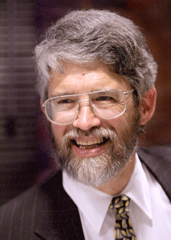
Presidential science advisor John Holdren.
CURWOOD: From the Jennifer and Ted Stanley studios in Somerville, Massachusetts, this is Living on Earth. IÂ’m Steve Curwood.
YOUNG: And IÂ’m Jeff Young.
Back in 2007 it took a court order to get the Bush administration to follow a congressional mandate and issue a comprehensive report about climate change. But the Obama administration has embraced the opportunity enthusiastically.
Its 192-page report is called “The Global Climate Change Impacts in the United States.” It’s heavy on the science, but it lays out the challenges in dramatic, accessible language.
Thirteen government agencies collaborated on the effort, including the National Oceanic and Atmospheric Administration, which is headed by Jane Lubchenco.
LUBCHENKO: First and foremost, human induced climate change is a reality not only in remote polar regions and in small tropical islands, but every place around the country in our own backyards. Climate change is happening and itÂ’s happening now.
CURWOOD: Today the levels of heat-trapping gasses in the atmosphere are setting us on a course to make our planet hotter than itÂ’s been in 800,000 years.
And the new report warns that if we do nothing the average surface temperature of the planet will continue to get even hotter, by as much as eleven degrees Fahrenheit by the end of the century.
President ObamaÂ’s top science advisor, John Holdren, presented the report at the White House. Dr. Holdren is a noted climate expert who in this administration holds the same rank as the PresidentÂ’s National Security Advisor. In a far-ranging conversation, John Holdren was both cautious and upbeat about the future.
HOLDREN: Well I would say the report is clear - the climate is changing – that the impacts are already being felt. In that sense it is a stark report. And in the sense that the projections show all of these adverse impacts getting steadily worse over time, if climate change proceeds unabated, it’s a stark report. But it’s optimistic in the sense that it tells us that if we take appropriate actions to reduce the emissions of the heat trapping pollution that is the main driver of this problem, we can greatly reduce the amount of climate change and the damage from it that occur in the future. And the report is optimistic as well because it is showing the way to steps we can take to adapt to climate change in ways that will reduce the harm over time.
CURWOOD: If the world and the United States doesnÂ’t address climate change, can you give me a couple of examples where people will really notice this.
HOLDREN: Well first of all I would say weÂ’re already noticing it. People are noticing changes in the growing seasons. TheyÂ’re noticing the increased frequency of wildfires, the increased frequency of floods in the United States. So the place to start is that we really are already experiencing adverse effects of climate change. What we will see if climate change continues unabated is all of these kinds of symptoms that IÂ’ve described will become more severe. I would say that people in the West are likely to notice increasing difficulties with water shortages. In the longer run, one of the most noticeable effects is likely to be the increase in sea level that comes from a warming world and that weÂ’re already experiencing at a rate that is about twice the rate of sea level rise in the 20th century. You would have in some parts of the country where there might be ten or twenty days a year over 100 degrees Fahrenheit now, you would in the future with these large increases in average temperature, you might have 100 or 150 days a year that exceed what you might call the threshold of very, very hot that would have large impacts on agriculture.

Climate change will mean more droughts in the U.S. West, with some places likely to experience more than 100 days per year with temperatures higher than 100 degrees Fahrenheit.
HOLDREN: I mean the productivity of food crops would go down. You wouldnÂ’t be able to grow as much corn or wheat on an acre of land as you can grow today because the heat stress on the plants would be damaging their capacity to grow and bear grain.
CURWOOD: Some people say look, weÂ’re on this path, climate change is inevitable, weÂ’re in it now, itÂ’s simply gonna get worse and the sense comes up that it may just be too late to do anything. How accurate is that?
HOLDREN: I absolutely disagree that it’s too late to do anything. What the science shows above all is that the more climate change we get the more difficult it’s going to be to cope with it. And we have opportunities by acting now and in the future to drastically reduce the amount of climate change we’re gonna be experiencing. I mean this is a very simple proposition: more is worse, less is better. And we have the opportunity, by taking action, to make it less – that’s what we ought to be doing.
CURWOOD: What do we need to do?
HOLDREN: We need to be reducing the emissions of heat trapping pollution and above all thatÂ’s carbon dioxide from burning the fossil fuels from which we get most of our energy today, that is from burning coal and oil and natural gas. What we need to do is to use those fuels more efficiently so we donÂ’t have to burn so much of them to get the goods and services that we need from energy. What we need to do is change the technologies we use to burn them so that we can capture a substantial part of the carbon dioxide that would otherwise be released and sequester it away from the atmosphere. We need to use more renewable technologies which donÂ’t emit carbon dioxide or as in the case of sustainably grown biofuels, only emit as much carbon dioxide when theyÂ’re burned as they removed from the atmosphere when they were grown. We need to see if we can address the obstacles that have impeded the expansion of nuclear energy in this country and elsewhere because nuclear energy too is a way to get electricity that does not emit carbon dioxide into the atmosphere. And we need to take steps to slow down and halt deforestation and other land use practices that are adding carbon dioxide to the atmosphere along with the burning of fossil fuels.
CURWOOD: Tell me: what are our range of options here? YouÂ’ve outlined how difficult things will be if we do nothing. If we do everything, do we still get to avoid more warming here?
HOLDREN: There is nothing that we can to do stop climate change in its tracks. ThereÂ’s a tremendous amount of momentum built into the climate system. We are not yet experiencing the full consequences of the heat trapping gases weÂ’re already added to the atmosphere, because of time lags in the way the global system responds. So we will see some continuing increase in global surface temperature and regional increases in surface temperatures no matter what we do. But, we have a big opportunity to minimize the amount of change we will experience. The aim that most scientists who study this matter have agreed is one that is still within reach and is highly desirable, would be to stabilize the concentration of heat trapping gases in the atmosphere at a level that would limit the global average surface temperature increase to about three and a half degrees Fahrenheit above the pre-industrial level. Now, if we do everything right, I think we can achieve that. And to tell you what that means, you really have to look at this, first of all, at the global level, because it is the global concentration of these heat-trapping pollutants that determine how much the temperature goes up.
CURWOOD: Now, as I understand it, between the United States and China, there are about 40 percent of the worldÂ’s emissions of carbon right now. And I also understand that you were in China with the negotiating team on the Global Climate Change Treaty recently. What do we need China to do in order to have a reasonable agreement on limiting greenhouse gases for the world?
HOLDREN: Well first of all it is correct that China and the United States are the two largest emitters of greenhouse gases in the world, and we do total something in the range of 40 percent of global emissions. And that means that there is no way that the problem can be solved without doing both of us taking very significant actions to reduce our emissions. The United States and China are both already doing a number of things to reduce their emissions but we need to do much more. And it has to be expected because the United States is an advanced industrialized country and China remains a developing country, that the United States along with the other industrial nations is going to have to do more sooner – my personal judgment would be that the United States and the other industrialized nations should peak no later than 2015 and be sharply declining in their emissions after that. And that China and other developing countries need to peak between 2020 and 2025, and be sharply declining after that.
CURWOOD: Assess for me the odds of President Obama going to Copenhagen at the conclusion of the current round of international negotiations on climate change. Will he be there do you think?
HOLDREN: I simply cannot comment on that. I just donÂ’t know at this juncture. It will obviously depend on a whole array of issues in terms of whatÂ’s on the PresidentÂ’s plate at the time, and whether it appears that there would be a significant benefit from his going to Copenhagen. And I think itÂ’s much to early to predict how that will come out.
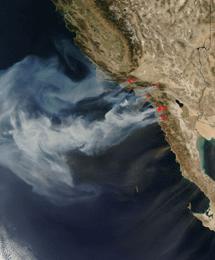
NASA's Terra satellite in 2007 captured an image of Southern California wildfires, expected to become more frequent as the planet warms up. (Courtesy of NASA)
HOLDREN: First of all, IÂ’m not sure that the President not going would mean that negotiations had failed. It might mean the negotiations had succeeded without him and he didnÂ’t need to go. He could simply celebrate the success from Washington. But the second thing I would say is we do need an agreement in Copenhagen. And weÂ’re working very hard with our various international partners to make sure that that happens. But the most important single thing the United States can do is to get its own house in order by passing a comprehensive energy climate bill and having that legislation in place because that will demonstrate that the United States is finally prepared to take the leadership role that the world expects of us in addressing this challenge.
CURWOOD: So, there you are in the Executive Office Building. YouÂ’re at the White House. If for a moment, the proverbial magic wand was put in your hand to do anything about this, what would be the first thing you would do.
HOLDREN: The first thing I would do is get enough votes in the House and in the Senate to pass a comprehensive energy and climate bill.
CURWOOD: The second thing?
HOLDREN: The second thing I would do is advise the President to sign it.
CURWOOD: And the third thing?
HOLDREN: The third thing I would do is work with industry, government, NGOs, universities and so on to generate the degree of innovation in energy technology that will enable us to meet those targets in the most cost effective possible way.
CURWOOD: As science advisor, whatÂ’s the one thing that youÂ’d love to do that you just canÂ’t do?
HOLDREN: Take vacations.
[LAUGHING]
CURWOOD: The climateÂ’s not waiting is it?
HOLDREN: [laughing] The climate is not waiting.
CURWOOD: John Holdren is President ObamaÂ’s science advisor. Thank you so much.
HOLDREN: My pleasure. Glad to be with you.
YOUNG: Coming up: the few, the proud, the poisoned-- Marine veterans still living with a legacy of contamination. Keep listening to Living on Earth.
Related links:
- **WEB EXTRA** Listen to all of Living on Earth's interview with John Holdren.
-
- Check out a 2002 Living on Earth interview with John Holdren here.
- Click here to learn about progress on international negotiations on climate change here.
-
[MUSIC: Richard Groove Holmes “It’s Impossible” from Groove Merchant Super Funk Collection (LRC Limited 2008)]
Polluted Patriots

Male breast cancer survivor Jim Fontella, stationed at Camp Lejeune from 1966 to 1967. (Photo: Patty Izzo, Courtesy of Jim Fontella from Michigan)
CURWOOD: ItÂ’s Living on Earth, IÂ’m Steve Curwood.
YOUNG: And IÂ’m Jeff Young.
[MARINE CORPS ANTHEM: “WE WILL FIGHT OUT COUNTRY’S BATTLES ON THE LAND, AIR AND THE SEA,” Marine Corps band “Marine Corps Hymn” from Liberty For All (Altissimo 2007)]
YOUNG: The US Marine Corps' anthem says they'll tackle the enemy on land or water.
But for many thousands of marines who lived on the corpsÂ’ Camp Lejeune in North Carolina the enemy, it turns out, was the water.
From the mid 1950s to the mid 80s drinking water at Lejeune was tainted with a potent stew of toxic chemicals including dry cleaning agents and degreasing solvents from the baseÂ’s machine shops and junkyard.
Master sergeant Jerry Ensminger served nearly a quarter century in the corps, and spent ten years at Camp Lejeune in the 1970s and 80s.
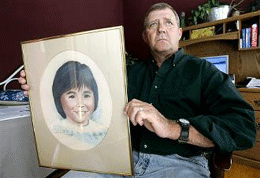
Jerry Ensminger holding a portrait of his daughter. (Courtesy of Jerry Ensminger)
ENSMINGER: I was walking into my living room with a plate of spaghetti to watch the evening news and the reporter said that the chemicals that had been found in Camp LejeuneÂ’s drinking water were linked to childhood cancer, primarily leukemia and that is what my child died of. I dropped my plate right there in the living room floor.
YOUNG: Tell me about your daughter, Janey.
ENSMINGER: Well Janey was one of my four daughters, she was the only one that was conceived on Camp Lejeune, and when Janey turned six years she was diagnosed with acute lymphocytic leukemia. And basically I watched my little girl go through hell for nearly two and a half years and I watched her die a little bit at a time, and she died on 24th of September, 1985, the same year that the Marine Corps decided to take their contaminated wells offline.
YOUNG: Ensminger devoted much of the past decade to learning about the connection between LejeuneÂ’s water, his daughterÂ’s disease, and ailments reported by other Camp Lejeune vets and their families.

Jerry EnsmingerÂ’s daughter Janey before leukemia. (Courtesy of Jerry Ensminger)
The National Academy of Sciences' National Research Council just released its review of the contamination and links to health effects. But those hoping for firm answers were disappointed.
I spoke with Cal Baier-Anderson, a health scientist for the Environmental Defense Fund who was a member of the Academy panel.
BAIER-ANDERSON: The scientific data that's available to us cannot confirm whether their health effects are associated with the exposures that they received while living or working at Camp Lejeune.

(Courtesy of Jerry Ensminger)
BAIER-ANDERSON: My message would be that science can't always answer these very important and critical questions, in fact, rarely do we have conclusive proof. What we do know is that people were exposed to toxic chemicals, and that the toxic chemicals are associated with a wide variety of adverse health effects. And based on these facts that we have in hand we believe that the Navy or Department of Defense should move forward with policy decisions as quickly as possible based on these facts.
YOUNG: Baier-Anderson says incomplete data about water delivery at the base and the complex nature of exposure led the panel to conclude that further study is unlikely to give any better results.
Others say the National Academy could have done more. Boston University professor of public health Richard Clapp has been working with a community advisory panel at Camp Lejeune for three years. Dr. Clapp is well known for his work on high profile water contamination cases and the National Academy asked him to review the panelÂ’s work. He wrote a blistering critique. Dr. Clapp told me heÂ’s especially unhappy with the way the panel characterized the cancer causing potential of the two main contaminants, the solvents tricholorethylene (TCE) and perchloroethylene or PERC.
CLAPP: They said there are no—either sufficient causation or sufficient association relationships they could identify from literature. That's a very conservative reading of the literature, in fact previous National Academy reports have gone further than that, so they're actually taking a step backwards to give such low ranking to these two major chemicals.

Male breast cancer survivor Jim Fontella, stationed at Camp Lejeune from 1966 to 1967. (Photo: Patty Izzo, Courtesy of Jim Fontella from Michigan)
CLAPP: I think they dropped the ball, and during the last administration National Academy committees were not the gold standard. There was a National Academy committee that looked at the EPA's dioxin reassessment and came out with a similar kind of pro-industry, assume the chemical is innocent until guilty type of report. And I'm here to say that I think that that's what this National Academy report was like on the Camp Lejeune studies, it was a give the benefit of the doubt to the pollution, not to the victims.
YOUNG Dr. Clapp says the TCE contamination at Lejeune is among the worst heÂ’s seen. The federal drinking water limit is five parts per billion. At at least one point, a well on Lejeune had 1400 parts per billion.
A half dozen other scientists are joining him in a letter to the Academy outlining their concerns. He thinks federal agencies investigating the Lejeune contamination should continue their work and largely ignore the AcademyÂ’s report.
But other public health advocates see value in the National AcademyÂ’s findings, especially the recommendation that further study should not be an excuse to delay action. Again, Academy panelist Cal Baier-Anderson.
BAIER-ANDERSON I think what people might be missing is this critical message that what we're saying is people were exposed to chemicals in their drinking water and these chemicals are associated with toxic health effects, and that should be the basis of policy decisions, not waiting for some level of causal determination. And I actually think that in many cases the bar to prove causality for situations like this where you have environmental exposures is so high that you know, really having us come out and say 'look if people are exposed,” that's an important fact.
YOUNG A spokesperson for the Marines says officials are still reviewing the AcademyÂ’s report.
Congress is also pushing for action. The SenateÂ’s Armed Services Committee will probably hold hearings. And both North Carolina Senators have given the Navy Secretary until the end of the month to respond to questions about how the contamination was handled.
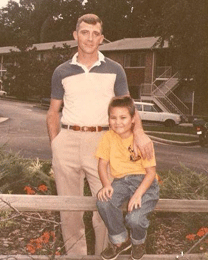
Jerry Ensminger and his daughter Janey at Camp Lejeune in the '80s. (Courtesy of Jerry Ensminger)
ENSMINGER: “Semper fidelis” is the, official motto. It's Latin and it means always faithful, and I have unfortunately discovered through this fight that the only way that you can make them live up to that is to force them to do it.
I will give this up whenever the organization that I served proudly, the U.S. Marine Corps, lives up to our motto and our slogan, or whenever they pat me in the face with a shovel and blow taps over me.
YOUNG: You can read more about the contamination at Camp Lejeune and Jerry EnsmingerÂ’s campaign at our website, loe.org.
Related links:
- Read more about the National Research Council report on Camp Lejeune.
-
- Check out the web campaign of Jerry Ensminger and other former Camp Lejeune residents.
[MUSIC: Ernest Ranglin: “Soulful Moments” from Gotcha (Telarc 2001)]
The Language of Landscape
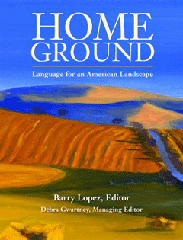
Just ahead– a blue way to fight the war on drugs– but first, we step into our occasional series, Home Ground.
[MUSIC: Boards Of Canada “Zoetrope” from “In A Beautiful Place Out In The Country” (Warp Records 2000)]
CURWOOD: Landscape exerts a hold on many of us – those blue remembered hills, the scent of that swamp, the folds of the valleys. The very names of our country’s features stir emotions. Some of its unique places are described in the book “Home Ground: Language for an American Landscape”, compiled by Barry Lopez and Debra Gwartney.
Today, poet Pattiann Rogers reads her description of “tule”.
ROGERS: Tule derives from the Aztec tullin or tollin, meaning any of several wetland plants, specifically bulrushes. The tules are marshy, swampy wilderness regions in California where these grasslike perennial herbs, cattails, bulrushes, and sedges are prevalent and may reach heights of fifteen to twenty feet. Tule has given its name to the small California elk, the tule elk, once nearly extinct, and to a population of the California marsh wren, the tule wren. Because of the thick, harsh wildness of the tule areas, “to be deep in the tules” means to be in trouble. “To pull freight for the tules” means to run from the law. In An Apostle of the Tules, Bret Harte describes the tules in Tassajara Valley, California, this way: “A more barren, dreary, monotonous and uninviting landscape never stretched before human eye…the breath of the haunted tules in the outlying Stockton marshes swept through the valley.”
CURWOOD: Poet Pattiann Rogers lives in Colorado. Her definition of “tule” comes from “Home Ground: Language for an American Landscape”, edited by Barry Lopez and Debra Gwartney.
Related link:
For more on the Homeground project, click here.
[MUSIC: E.S.T.: “All The Beauty She left behind” from Viaticum” The Platinum Edition” (ACT 2005)]
Harvesting Tattoo Ink, not Coca

A bag of jagua is weighed before being put onto a Cessna for the flight to the city of Medellin for processing. (Photo: Conrad Fox)
When it comes to the illegal cultivation of coca – the plant used to make cocaine, a new report from the United Nations finds mixed trends in the Andean region of South America.
The UN found coca production increased slightly in Bolivia and Peru, but dropped significantly in Colombia. Officials attribute the decline in Colombia to the widespread use of pesticides and the uprooting of coca crops, activities supported by United States troops.
But the U.S. backed program Plan Colombia has also been helping farmers grow legal crops and bring them to market.
Conrad Fox has our report from western Colombia.
[SOUND OF RAIN FALLING AND MEN TALKING]
FOX: It's pouring rain in the village of Napipi. On the bank of a slow moving muddy river, women wash pots while children play in the water. A group of men gather to discuss their prospects. One of them is Mardonio Sanchez.
[MARDONIO SPEAKING SPANISH]
VOICEOVER: Right now the economy is really bad. Timber production is way down. The river floods out our crops. The banana harvest, corn, everything else is way down. We're all flat broke right now.
FOX: One of the few sources of cash around here is logging, much of it illegal. But the trees are running out, and with it their income. It's the kind of desperate situation that leads many in Colombia to grow coca. Mardonio admits it's tempting.
[MARDONIO SPEAKING SPANISH]
VOICEOVER: We don't have it here, but you hear about coca. It's essentially money. You just harvest it and there's your money.
FOX: They may not have seen it yet, but they could soon. Once confined to the south of Colombia, coca has been gradually spreading to other regions, including Choco. As it does, it leaves behind a swath of destruction. In the last eight years in Colombia, 336 square miles of old growth forest – that’s about the size of New City’s five boroughs - have been cleared to make way for coca. Meanwhile, the army, funded by the U.S. government, sprays more than that every year with herbicide. They do it to eliminate coca plantations, but locals complain it kills surrounding forest too.
[SOUNDS OF BIRDS AND VOICES]
FOX: Mardonio and his friends say they don't want that to happen here. Later in the day, the men head to the forest.
[FRUIT DROPPING]
FOX: Twenty-five feet up a tree, one of MardonioÂ’s friends plucks fruit and sends it falling to the ground, narrowly missing his colleagues below.
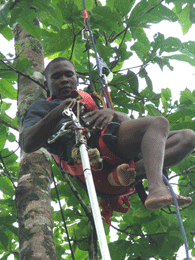
Cutting jagua from the trees. (Photo: Conrad Fox)
FOX: Laughing, they cover their heads and bag the fruit, which they call the “jagua”. The jagua is about the size of an avocado, and inside is a deep blue pulp that can stain your skin for days. It's perfect for temporary tattoos.
[MAN SPEAKING IN SPANISH]
FOX: “I don’t like tattoos,” says one of the men, screwing up his face. “They’re for tourists.”
[MAN SPEAKING IN SPANISH, LAUGHTER]
FOX: The jagua pulp will be turned into tattoo ink and shipped to Europe for sale. The men may not like tattoos, but they do like the money it brings in. The average wage for a laborer here is about $7 dollars a day. On good days, a jagua collector can make more than six times that.
[MARDONIO SPEAKING IN SPANISH]
FOX: “The jagua is our coca,” laughs Mardonio. But unlike coca, the jagua is a sustainable product. The trees are naturally-occurring, so they don't have to tear down forests to plant them.
[SOUNDS OF A MOTOR BOAT]
FOX: The men load about a dozen large sacks of jagua onto a boat and head upstream. Abandoned villages line the riverbank, reminders of the bloody fighting between paramilitaries and FARC rebels that has plagued this region for years. Rebels still roam the forest, but the army now has firm control of the river. The army is funded by Plan Colombia, the same program that gives the jagua farmers their funding.
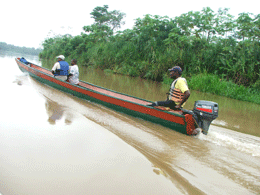
Jagua farmers use a motorboat to transport the fruit. (Photo: Conrad Fox)
FOX: That's Susan Reichle, Deputy Director for the Colombia branch of USAID, the US government's international development agency. Every year her department spends about $100 million dollars investing in projects that she hopes will provide an alternative to growing coca, with products like coffee, flowers, banana, or sugar. The jagua farmers have received $300,000. It's the carrot to Plan Colombia's counter-narcotics stick.
REICHLE: The question we get asked very often, why would people leave a lucrative industry, a lucrative crop—and purely because they want to move into the legal economy. They do not want to live with violence, and coca—they understand, it comes with violence.
[SOUNDS OF UNLOADING, GRUNTING]
FOX: The jagua farmers beach their boat and haul the sacks of fruit up to an improvised airstrip. With no roads, the only way to send the jagua for processing is an hour-long flight by small plane to Medellin. It's expensiveÂ…
[SOUND OF A PLANE]

A bag of jagua is weighed before being put onto a Cessna for the flight to the city of Medellin for processing. (Photo: Conrad Fox)
COCK: These candies, the Smarties, you don't find them anymore in blue in Europe, and kids are dying to get their blue Smarties back. (laughs). We have developed a proprietary technology which makes it applicable for different uses including makeup, shampoos, conditioners, soaps, toothpaste, floor cleaners, Pepsi blue...
FOX: So basically you guys are into blue. This is your business, selling blue.
COCK: We want to make the blue world from the natural resource in order to promote sustainable development in our country.
FOX: A green blue
COCK: A green blue. Correct.

This child stained blue with jagua juice. The native Indians of the region use jagua as a fly-repellent and in ceremonies. (Photo: Conrad Fox)
[MAN SPEAKING IN SPANISH]
FOX: This man doesn't want to give his name. He admits he used to grow coca. Not anymore.
[MAN SPEAKING SPANISH]
VOICEOVER: Now, I've got lots of jagua trees producing lots of fruit. It's a healthier alternative for my family. And nobody comes after you for it. I'm old. I don't want to spend my last days in jail.
FOX: When Plan Colombia began ten years ago, economic assistance like the crop substitution program was just a small part of the budget. That kind of aid has been slowly increasing, even as military assistance has decreased, and the trend looks set to continue. Plan ColombiaÂ’s budget proposal for next year shows spending split equally between economic development and military aid.
For Living on Earth, I'm Conrad Fox in the Choco forest, Colombia.
YOUNG: Just ahead: Take a big dose of countryside and call me in the morning. How reconnecting with nature can save your sanity. Stay with us - on Living on Earth.
Related links:
- Ecoflora
- Click here for the Spanish-language website of ESPAVE, the farming cooperative producing the jagua.
- Learn more about USAID work in Colombia here.
[MUSIC: Los Galantes Valianatos: Cumbia Smapuesana” from Bailables Immortales (YoYo USA)]
Ecotherapy
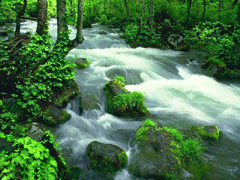
Therapists trade the couch for nature.
CURWOOD: Xanax, Zoloft, Prozac, Valium. These drugs fill many a medicine cabinet, helping folks relax and cope with depression and anxiety.
But what if a simple walk in the woods could dissolve that black cloud that lingers over your head instead? Linda Buzzell says thatÂ’s part of the treatment she offers her clients. She came into the studio to explain how an emerging practice called Ecotherapy blends nature with traditional psychotherapy.
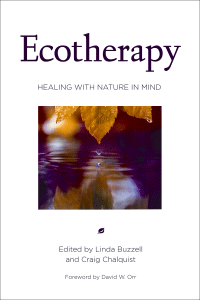
CURWOOD: Now someone listening to us might say “Hey, okay, this woman’s from Santa Barbara, California. They’ve got hot tubs and crystals and everything out there, and this is – well, hey, this is trendy, but maybe not so real.”
BUZZELL: [laughing] Well actually thereÂ’s a wonderful section of our book that was put together by my coeditor Craig Chalquist, and it details all of the research thatÂ’s been done that shows the nature connection is unbelievably powerful as a healing methodology. Keep in mind the fact that the University of Essex in the UK just did a really important study and they found that connecting with nature, a simple walk in nature, was as powerful an antidepressant as antidepressant medication in cases of mild to moderate depression.

Ecotherapist Linda Buzzell.
CURWOOD: How was it that you decided to incorporate nature into your practice of psychotherapy? Perhaps you could tell us a specific moment that took you down this path.
BUZZELL: Well IÂ’ve been a psychotherapist for over 25 years. And most of that time I wasnÂ’t doing anything to do with nature. But what happened to me was I started a garden. And I became amazed as I was doing this when I began to realize that it wasnÂ’t just me working the garden, that the garden was somehow changing me. And it was having these wonderful affects on my mood and my levels of anxiety, and I thought wow, this is really a very healing thing. I gotta find out more about it.
CURWOOD: So, tell me, Linda, what types of ailments does ecotherapy help with, and how does it differ from, say, traditional psychotherapy?
BUZZELL: Well an ecotherapist really might look at things differently and ask different questions in a session. The assumption of ecotherapy is that humans and nature are not disconnected. That the same way that weÂ’re embedded in a family or in a community, that weÂ’re also embedded in the rest of nature. So, one of the types of questions that an ecotherapist might ask is what is your relationship right now with the rest of nature? Do you have a practice in your life where you walk in nature or you go swimming or youÂ’re somehow connected with an animal or with a garden or a special place? And what meaning does that have for you? And, of course, these are not questions that are typical in psychotherapy, and yet they often evoke a flood of emotion from people.

The new prescription for depression.
BUZZELL: Well one of the interesting things might be that we might not do the session in my office. That I actually have a backyard food forest, a permaculture type backyard food forest on my, you know, not very big lot, with 102 fruit trees. And we might actually go out into the garden and just sort of acknowledge by doing that that weÂ’re part of something larger. ThereÂ’s a condition that people are beginning to talk about now thatÂ’s called ecoanxiety. And it really is the stress, the worry that people have about the state of the environment as more and more of us, weÂ’re waking up and realizing, weÂ’ve kinda screwed up. And now we have to kind of back off and take a whole nother look at this. But if you came to therapy with ecoanxiety, I think one of the things that an ecotherapist might do is acknowledge the reality and the seriousness of your concerns and not just tell you that you really should just take some Prozac or some Xanax and not worry about it.
CURWOOD: So when you have people come to you who do have anxiety and depression and arenÂ’t on medication, what do you do with them?
BUZZELL: One thing that I sometimes ask people to do is fill out a time diary. And a time diary helps them see how much time they spend inside versus outside. How much time they spend looking at a screen, whether itÂ’s a computer or a blackberry or whatever it is, or a television versus how much time they spend looking into the faces of other people or into nature. And its often really amazing to see the results, and people realize that weÂ’re living very, very unnaturally, and that it actually may be true that the way that we live may be causing these epidemics of depression and anxiety that go on in Western civilization. So, one of the easy things that we can do is begin to shift the lifestyle just slightly, have a little more nature, a little more calm, get off some of the media actually allow people to take a media fast for a couple of days and see if that helps at all in terms of helping the depression or lowering the anxiety levels.
CURWOOD: Hey, wait a second, Linda, you said turning off the media. I mean, youÂ’re gonna turn off the radio. YouÂ’re gonna put me out of work.
BUZZELL: [laughing] Well I didnÂ’t say forever. But itÂ’s very interesting. So many of us are living kind of media-oriented lives and just taking a little bit of a media fast has a very interesting effect.
CURWOOD: Linda Buzzell has a job as a therapist and also as the editor of “Ecotherapy – Healing with Nature in Mind.” It’s published by Sierra Club Books.
[MUSIC: Kyle Eastwood: “Bold Changes” from Metropolitan (Rendezvous Records 2009)]
Cool Fix for a Hot Planet
YOUNG: ItÂ’s Living on Earth. IÂ’m Jeff Young.
CURWOOD: And IÂ’m Steve Curwood.
Just ahead – burn, baby, burn - we mark the fortieth anniversary of the most famous Cuyahoga River fire – but first this Cool Fix for a Hot Planet from Liz Gross.
GROSS: Hybrid cars promise fuel efficiency, but their expensive batteries drive up the price. Now, a new breed of hybrids could produce a low cost and energy efficient solution right out of thin air.
Swiss engineers recently presented a pneumatic hybrid at the Automotive EngineersÂ’ Congress in Detroit.
Instead of storing excess energy in batteries, pneumatic hybrids use the engine’s pistons to store energy in the form of compressed air. The dense air is released when the car accelerates and drives the pistons. The boost of oxygen allows the engine to burn more fuel in a short burst – a process called supercharging.
With acceleration powered by supercharging, the engine only needs to produce enough energy to run the car at cruising speeds. This allows pneumatic hybrids to use an engine thatÂ’s one third the size of a conventional gas-powered engine, reducing fuel consumption by 32 percent.
Those energy savings are almost as high as those from electric-hybrids, and at a fraction of the price. The pneumatic hybrids only need minimal equipment to manage the compressed air, increasing engine costs by just 20 percent. ThatÂ’s compared to the 200 percent increase for the battery and other parts needed for gas-electric cars.
With these lower costs, pneumatic hybrids could ensure that pledges to lower emissions are more than a bunch of hot air.
ThatÂ’s this weekÂ’s Cool Fix for a Hot Planet. IÂ’m Liz Gross.
YOUNG: And if you have a Cool Fix for a Hot Planet, we'd like to know it. If we use your idea on the air, we'll send you a shiny electric blue Living on Earth tire gauge.
That’s right, keeping your tires properly inflated can save hundreds of dollars a year in fuel costs. So call our listener line at 800-218-9988, that's 800-218-99-88. Or email coolfix—that's one word—at loe.org. That's coolfix@loe.org.
Related link:
Learn more about pneumatic hybrids here.
Putting out the Cuyahoga

The Cuyahoga River runs through the industrial zone of Cleveland, Ohio. Engineers have straightened and dredged the river to make it easier for ships to get through. (Courtesy of EPA)
[MUSIC: Randy Newman “Burn On” from Sail Away Remastered (Earner Bros. 2005)]
YOUNG: This month marks the 40th anniversary of a watershed moment in environmental history: June 22, 1969 the Cuyahoga River caught fire in Cleveland.
It was hardly an isolated event. The Cuyahoga was so heavily and chronically contaminated it burned at least a dozen times. Riverboat pilot Wayne Bratton recalls seeing the river in flames in the mid 70s.

Firefighters struggle to extinguish a fire on the Cuyahoga River in 1952. (Courtesy of NOAA)
YOUNG: Locals were a bit blase about the burning river, but national media attention sparked outcry over the sad state of our rivers and lakes. That helped give rise to the US Environmental Protection Agency and landmark laws like the Clean Water Act. Those laws and agencies are largely credited with cleaning up our rivers.
But on the Cuyahoga, the actual work of cleaning was up to people like Frank Samsel. Samsel spent much of his life on the Cuyahoga aboard a boat he designed called the Putzfrau, a very special vessel that lived up to its name.
SAMSEL: Putzfrau, itÂ’s kind of German for cleaning lady. And the function of the boat was to clean up floating debris and oil on the river. On the front of the boat is a vacuum and it picks up small debris and oil off the surface of the water. And because oil is kind of tenacious, you know, it has a tendency to cause things to kinda of glom together. Where the current slowed down in the navigable channel, it collected debris into very large mats, maybe an acre and a half or two acres on the surface.
YOUNG: Wow.
SAMSEL: And weÂ’d go in and weÂ’d clean this stuff up.
YOUNG: What was an average day? How much junk would you pick up off the river?
SAMSEL: In about sixteen hours, we could pick up about 100 cubic yards of debris and about 15,000 gallons of oil. And you gotta realize that at that time we were in a different economy. Black oil, at that time, number six, was 3 cents a gallon, you know.
YOUNG: So, if you spilled a little it wasnÂ’t that big a deal.
SAMSEL: Well, itÂ’s cheaper to spill it than to spend the time on labor on back flushing and cleaning and, you know, so you spill a barrel of oil. So what, you know. You lost two dollars, maybe.
YOUNG: Right.
SAMSEL: Big deal, you know. You put that against five men’s labor fiddling around for forty-five minutes. It’s cost effective to do that. You know, that was an obvious polluter. At one time we walked around the gasoline - we had six buckle boots on – we were walking in gasoline up to our ankles. And you know you’re really concerned because one spark or something like that and you’re toast.

The Cuyahoga River in Ohio runs through Cleveland to empty into Lake Erie.
SAMSEL: Yes. Industry got the bad name, but as Pogo says, you know, we have met the enemy and he is us.
YOUNG: Uh-huh.
SAMSEL: Well thatÂ’s what we found out. We found out that weÂ’re putting raw sewage into the river.
YOUNG: Describe for us what the Cuyahoga was like in say late 60s early 70s. Just paint us a picture of that river.
SAMSEL: Well about this time of the year would start, the river would go completely anaerobic, no oxygen, none whatsoever. And it would start to percolate, it would bubble. The sewage – it was like a gigantic catch basin or a septic tank. And it would just collect this stuff. And it stunk to high heaven. We had a river that had a lot of floating debris on it because there was a time when that’s where you threw your grass clippings, that’s where all the stuff goes, you throw it in the river and it goes away and you don’t worry about it. And I’m talking about the public as well as private industry. They’d throw whatever – and don’t forget we had a big plating industry. And that the pickle tanks that they would pickle stuff in and the other tanks would have to be flushed out occasionally. You know these forty, fifty thousand gallon tanks would be dumped into the river and it would make a great huge black blob in one spot and you could see it move down the river as the current moved it down. So no matter who told you how bad it was, at that time, they weren’t exaggerating. It was bad. Chemical companies would throw their stuff in there so you might have a coat of acid on top. We had a supply business, fellows would come down occasionally and one guy came down once and he said “we’ve got this coating, it’s really marvelous.” And I said “well, let me try it out”. So he had a sample on a piece of tin. And I put a piece of wire on it and I hung it in the river. And I said, well you could back in ten days, and we’ll see what this coating’s like. And he says, “this is a marvelous thing”. So ten days later he came back, I pulled the piece of tin out of the river, and took my finger nail and a scraped the coating off the metal. And I said, “well you need a little work on this yet.”
[LAUGHING]
YOUNG: You were like the proving ground for these thingsÂ…
SAMSEL: Well for that particular individual, yeah, and he couldn’t believe it. We had a launch that we would service the oar fleet* with and I said “You know, see the launch? There’s no paint from the water line down. And there’s no rust. The acid and the chemicals, they took the paint off and the oil coats it. I said we don’t have rust on the outside of the boat and we don’t have paint because nothing sticks to it. You could bring a salt water vessel in there and all the barnacle would drop off [laughing] because ….
YOUNG: Wow.
SAMSEL: It did the trick.
YOUNG: Well thatÂ’s a pretty vivid image. I mean the picture youÂ’re painting for me here is a bubbling lifeless cesspool covered with chemicals and oil and debris.
SAMSEL: That stunk.
YOUNG: That stunk. LetÂ’s not forget stinking.
SAMSEL: You canÂ’t emphasize that enough. I mean it was horrible.
YOUNG: So that was the Cuyahoga then.
SAMSEL: Yeah.
YOUNG: Now describe the Cuyahoga for me today.
SAMSEL: ItÂ’s really, itÂ’s turned around. If you know where to go in the Cuyahoga River youÂ’ve got some of the finest steelhead fishing there is. YouÂ’ve got some of the finest bass fishing there is. In the summer, of course, now we have tremendous walleye fishing. People say itÂ’s the walleye capitol of the world. WeÂ’ve got people coming from Minnesota and Wisconsin and Michigan down here to fish in Lake Erie.

(Courtesy of EPA)
SAMSEL: You could imagine it, but you wouldn’t think that it would happen this quick, because it was so bad, that you’d say “well they’ll probably clean it up, but not in my lifetime.” And the changes have been really tremendous. You like to brag about it, but still, we’d like to keep the fishing for ourself.
[LAUGHING]
SAMSEL: We donÂ’t want people coming from everywhere.
YOUNG: So donÂ’t tell everybody. I wonÂ’t tell everybody, okay?
SAMSEL: Okay. WeÂ’ll keep it between ourselves.
YOUNG: Well Frank Samsel has been talking with us about cleaning up the Cuyahoga River, and Mr. Samsel, I hope you get lots of opportunities to enjoy the fruit of your labor and get out there and do lots of fishing.
SAMSEL: Thank you very much and goodbye now.
Related links:
- A WKSU report on the Cuyahoga
- Northeast Ohio Regional Sewer District
[MUSIC: REM: “Cuyahoga” from And I Feel Fine, The Best Of The IRS Years 1982 – 1987 (Capitol records 2006)]
[SOUND OF TREEFROGS BLEATING]
YOUNG: We leave you this week in a narrow canyon. In the Lake Mead National Recreation Area in Arizona, Canyon treefrogs bleat loudly on a warm March evening. And if you listen closely, you might hear the faint chuckling of the relict leopard frog. There are only a few known populations of this rare frog - most of them in the Lake Mead region.
Jeff Rice made this recording for the University of Utah Marriott Library, westernsoundscape.org.
(EARTHEAR RELATED LINKS:
The Institute of Museum and Library Services funds the Western Soundscape Archive: http://www.imls.gov/
Visit the Western Soundscape Archive: westernsoundscape.org)
CURWOOD: Living on Earth is produced by the World Media Foundation. Our crew includes Bobby Bascomb, Eileen Bolinsky, Bruce Gellerman, Ingrid Lobet, Helen Palmer, Jessica Ilyse Smith, Ike Sriskandarajah, and Mitra Taj, with help from Sarah Calkins, Marilyn Govoni, Sammy Souza, and Dana Chisholm.
YOUNG: Our interns are Annie Glausser and Lisa Song. Jeff Turton is our technical director. Alison Lirish Dean composed our themes. You can find us anytime at loe.org.
IÂ’m Jeff Young.
CURWOOD: And IÂ’m Steve Curwood. Thanks for listening.
Living on Earth wants to hear from you!
Living on Earth
62 Calef Highway, Suite 212
Lee, NH 03861
Telephone: 617-287-4121
E-mail: comments@loe.org
Newsletter [Click here]
Donate to Living on Earth!
Living on Earth is an independent media program and relies entirely on contributions from listeners and institutions supporting public service. Please donate now to preserve an independent environmental voice.
NewsletterLiving on Earth offers a weekly delivery of the show's rundown to your mailbox. Sign up for our newsletter today!
 Sailors For The Sea: Be the change you want to sea.
Sailors For The Sea: Be the change you want to sea.
 The Grantham Foundation for the Protection of the Environment: Committed to protecting and improving the health of the global environment.
The Grantham Foundation for the Protection of the Environment: Committed to protecting and improving the health of the global environment.
 Contribute to Living on Earth and receive, as our gift to you, an archival print of one of Mark Seth Lender's extraordinary wildlife photographs. Follow the link to see Mark's current collection of photographs.
Contribute to Living on Earth and receive, as our gift to you, an archival print of one of Mark Seth Lender's extraordinary wildlife photographs. Follow the link to see Mark's current collection of photographs.
 Buy a signed copy of Mark Seth Lender's book Smeagull the Seagull & support Living on Earth
Buy a signed copy of Mark Seth Lender's book Smeagull the Seagull & support Living on Earth

